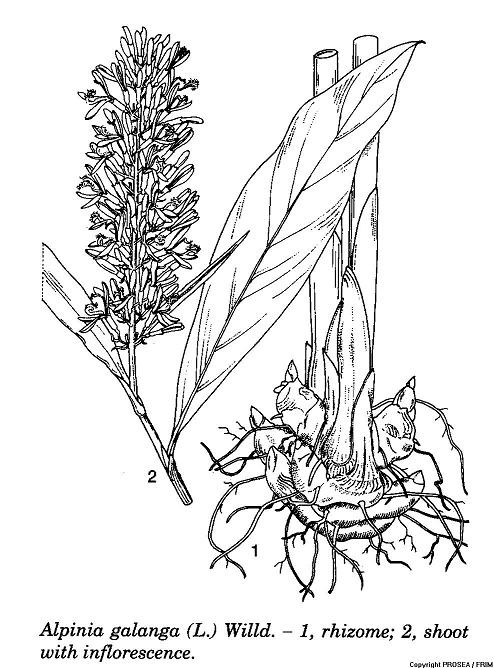Family
Zingiberaceae
Synonyms
Languas vulgare J. Koenig, Amomum galanga (L.)Lour., Languas galanga (L.) Stunts
Vernacular Names
| Malaysia | Lengkuas, puar |
| English | Galanga, Greater galangal |
| Indonesia | Langkuas (General), laos (Javanese), laja (Sundanese) |
| Philippines | Langkauas (General), palla (Mandaya) |
| Burma (Myanmar) | Padagoji |
| Cambodia | Rumdeng, pras |
| Laos | Kha:x ta: de:ng |
| Thailand | Kha, kha yuak (Northern), katuk karohinee (Central) |
| Vietnam | Ri[ee[]ng n[ees]p, s[ow]n n[aj]i, h[oo[]ng d[aaj]u kh[aas]u |
| French | Galanga |
Geographical Distributions
Tropical Asian and South-East Asian countries.
Description
A. galanga is a robust herb up to a height of 3.5 m. This 2-4 cm in diametre rhizome is copiously branched in light red or pale yellow. It is fragrant.
The leaves form is oblong lanceolate and the size is about (20-)50(-60) cm x (4-)9(-15) cm;it is sub-hairless, glossy green, densely white-dotted, ligule truncate of about 1 cm long and densely pubescent. The petiole is between 1-1.5 cm long and hairy.
Its inflorescence is raceme-like, erect, many flowered with a size of about 10-30 cm x 5-7 cm, it is pubescent, the bracts is egg-shaped, up to 2 cm long, with each subtending a cincinnus of 2-6 flowers. Its secondary bract is smaller and the 3-4 cm long yellow-white flowers are fragrant. The sepal is tubular, about 1 cm long, white, petal tube is terete that about 1 cm long; it has 3 recurved lance-oblong lobes about 1.5 cm x 0.6 cm. The margins have fringe of hairs in greenish-white. Its labellum is a spoon-shaped form about 1.5-2.5 cm x 0.5-0.75 cm, white veined with lilac to purple, clawed, it is undulate crenate at the margin while the apex is recurved inwards, lateral staminodes represented by 2 sharply pointed lobes at the base of the labellum which about 7-8 mm long, reddish, stamen erect, anther incurved and 2-2.5 cm long.
The form of capsule is spherical to elliptical and its diametre is 1-1.5 cm. The colour is orange-red to wine red, black when mature and produce 2-3-seeds.
Ecology / Cultivation
A. galanga occurs in cultivation and semi-wild near villages, or at the borders of secondary forest. It requires sunny or moderately shady locations. Soil should be fertile, moist but not swampy. Sandy-soils rich in organic matter and with a good drainage are preferred.
Line Drawing / Photograph
Read More
1) Cultivation
2) Malaysian Herbal Plants
References
- Plant Resources of South-East Asia No 12(2). 1998, Unesco.



